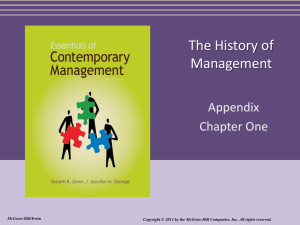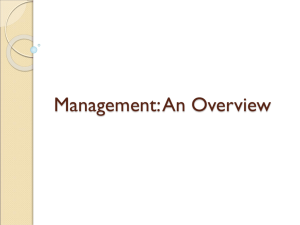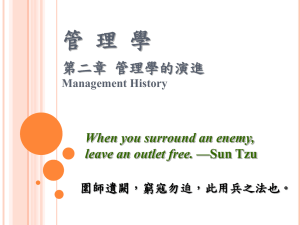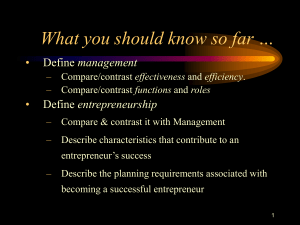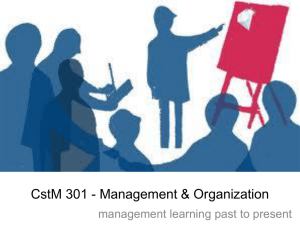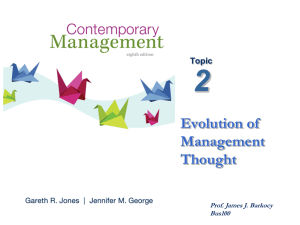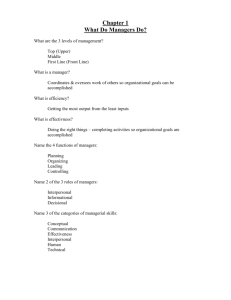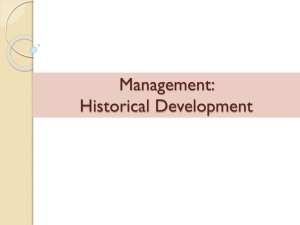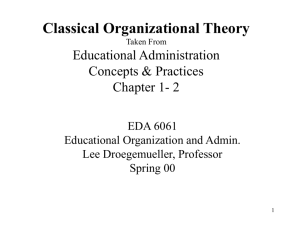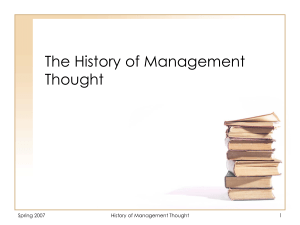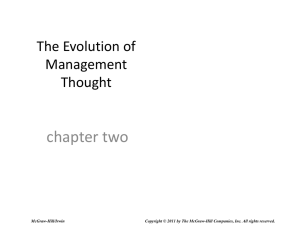Introduction to Management
advertisement
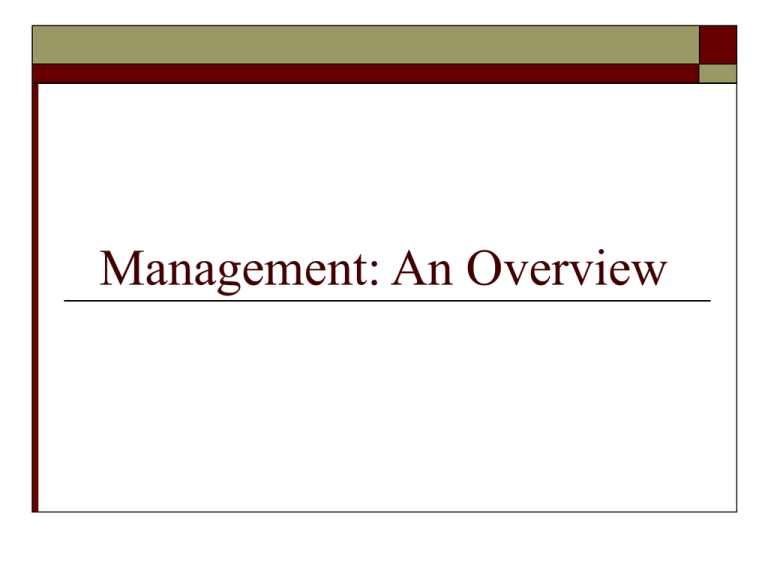
Management: An Overview Organization Organization is a system which operates through human activity. Organizations are very complex social formations, their links can’t be described with only one theory. Organization Theories concerns 3 levels: Macro: cooperation among different organization Mezzo: structures of the organizations, and influencing factors Micro: behavior of the members of the organizations, motivation, conflict etc. What is Management? Definition: Coordinating work activities so that they are completed efficiently and effectively with and through other people Efficiency: getting the most output from the least input Effectiveness: completing activities so that the organization’s goals are attained. Management is… Getting work done through others Efficiency Effectiveness Managerial Roles Interpersonal Informational Decisional Figurehead Monitor Entrepreneur Leader Disseminator Disturbance Handler Liaison Spokesperson Resource Allocator Negotiator Management Functions Classical Management Functions Updated Management Functions Planning Making Things Happen Organizing Meeting the Competition Staffing Leading Controlling Organizing People, Projects, and Processes Levels of Management Top Level Management Middle Level Management First-Line Management CEO COO CIO General Mgr Plant Mgr Regional Mgr Office Manager Shift Supervisor Department Manager Team Leader Top Managers Responsible for… Creating a context for change Developing attitudes of commitment and ownership in employees Creating a positive organizational culture through language and action Monitoring their business environments Middle Managers Responsible for… Setting objectives consistent with top management goals, planning strategies Coordinating and linking groups, departments, and divisions Monitoring and managing the performance of subunits and managers who report to them Implementing the changes or strategies generated by top managers First-Line Managers Responsible for… Managing the performance of entry-level employees Teaching entry-level employees how to do their jobs Making schedules and operating plans based on middle management’s intermediate-range plans What Companies Look for in Managers Technical Skills Human Skill Conceptual Skill Design Skill Core skills and their use in the different levels Managerial levels Lower Middle Top Conceptual skills Human skills Technical skills Management Theory Pre-Classical Classical Approaches Behavioral Approaches Frederick Taylor: Scientific Management (1886) Frank and Lillian Gilbreth: Time/motion studies (later 1800s) Henri Fayol: 14 Principles of Management (1880s-1890s) Max Weber : Bureaucracy (1920s) The Hawthorne Experiment (1927) MacGregor’s Theory X and Theory Y (1960) Quantitative Approaches Contemporary Approaches Ouchi’s Theory Z (1981) Contingency Management Classical Approaches Frederick Taylor: Scientific Management (1886) Frank and Lillian Gilbreth: Time and motion studies (later 1800s) Henri Fayol: Fourteen Principles of Management (1880s-1890s) Max Weber : Bureaucracy (1920s) Frederick W. Taylor Developed Scientific Management Laid foundation for the study of management Key ideas: Management as a separate field of study Explicit guidelines for scientific study of management functions Time studies for setting standards Functional specialization of managers’ duties Piece-rate Incentive systems Taylor’s Principles of Management The “one best way.” Scientific selection of personnel Put right worker in right job, find limitations, train Financial incentives Management using scientific observation Putting right worker in right job not enough A system of financial incentives is also needed Functional foremanship Division of labor between manager and workers Manager plans, prepares, inspects Worker does the actual work “Functional foremen” , specialized experts, responsible for specific aspects of the job Frank & Lillian Gilbreth Time and motion efficiency experts Developed therbligs, breakdown of manual skills into 16 actions Frank was a lazy bricklayer looking for an easier way and Lillian was a psychologist. Endorsed piece-work and suggested a higher rate per unit if his directions were followed. Disagreed with Taylor’s idea that management should choose which workers took which jobs. Henri Fayol First came up with the five basic functions of management—Planning, Organizing, Staffing, Directing, Communicating, and Controlling First wrote that management is a set of principles which can be learned. Developed Fourteen Principles of Management HENRI FAYOL’s FOURTEEN PRINCIPLES OF MANAGEMENT 1. Specialization of labor. Specializing encourages continuous improvement in skills and the development of improvements in methods. 2. Authority. The right to give orders and the power to exact obedience. 3. Discipline. No slacking, bending of rules. 4. Unity of command. Each employee has one and only one boss. 5. Unity of direction. A single mind generates a single plan and all play their part in that plan. 6. Subordination of Individual Interests. When at work, only work things should be pursued or thought about. 7. Remuneration. Employees receive fair payment for services, not what the company can get away with. 8. Centralization. Consolidation of management functions. Decisions are made from the top. 9. Scalar Chain (line of authority). Formal chain of command running from top to bottom of the organization, like military 10. Order. All materials and personnel have a prescribed place, and they must remain there. 11. Equity. Equality of treatment (but not necessarily identical treatment) 12. Personnel Tenure. Limited turnover of personnel. Lifetime employment for good workers. 13. Initiative. Thinking out a plan and do what it takes to make it happen. 14. Esprit de corps. Harmony, cohesion among personnel. Max Weber Coined “bureaucracy”: the perfect office Well defined chain of command Clear division of work (job descriptions) Procedures for any situation Impersonality Employment and promotion based on technical competence. Behavioral Approaches The Hawthorne Experiment (1927) Chester Barnard (1930s – 1960s) Herbert Simon (1947) MacGregor’s Theory X and Theory Y (1960) The Hawthorne Experiment Research conducted at the Hawthorne plant of the Western Electric Company near Chicago, 1927-1937 Initial study: effects of lighting on worker performance But the “Hawthorne Effect” was instead identified The workers values, desires, and needs may be more important than physical conditions. Workers want to have input. Workers want to be respected. Theories X and Y Conducted in 1960s by Douglas McGregor Theory X: classical theory Most people dislike work and responsibility, they are motivated only by money and do not care about the job. Close supervision is required and people must be carefully controlled and coerced into working Average person prefers direction Theories X and Y Theory Y: Modern Management Theory People often enjoy their work and will exercise self-control at work. People are motivated by wanting to do a good job and will do well if the opportunity is presented People have capacity for imagination, ingenuity, and creativity People enjoy expending physical and mental effort in work as much as play and rest Contemporary Approaches Ouchi’s Theory Z (1981) Contingency Management Ouchi’s Theory Z Theory Z Value of culture in an industrial society Intimate and cooperative work relationships Alienated in work environment in which family ties, traditions, and social institutions are minimized Workers have strong sense of moral obligation, discipline and order Contingency Management Managing in Different and Changing Situations Require managers to use different approaches and techniques Contingency perspective - different ways of managing are required in different organizations and different circumstances stresses that there are no simplistic or universal rules contingency variable © Prentice Hall, 2002 Brief Behavioral Quantitative Approach Mary Parker Follet : “Power Sharing” Chris Argyris: Model I & Model II Organisations Management Science Operation Management MIS System Theory
